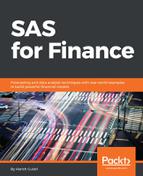Credit risk management is a highly regulated discipline. Analysts, modelers, project managers, and individuals in various roles within the discipline are expected to have a knowhow of the Basel accords.
The Basel accord was formulated by the Basel Committee on Banking Supervision (BCBS). The accord is a set of recommendations for regulatory mechanisms in the banking world. While the accord isn't binding, major and emerging economies of the world have made their recommendations binding through their own legislative processes. In 1998, the Basel Committee first published a set of recommendations for the minimum capital requirements of banks. Initially, the G-10 countries enforced these recommendations as laws. These recommendations are known as Basel I. The recommendations are focused on credit risk and the risk-weighting of assets. One of the main takeaways was that the banks with international presences were asked to hold capital equal to 8% of their risk-weighted assets (RWA).
The accord assumed significance, as it was meant to ensure that the credit risk was effectively managed. On the flip side, it also meant that for every penny lent by some banks, they needed to keep 8% of it aside for the capital adequacy ratio to be maintained. While effective credit risk management is a priority for any bank, they are also interested in holding on to minimum capital reserves, so that there can be more money available to earn from increased lending. Basel II laid the foundation of the advanced approach, which provided more flexibility to banks for assessing capital adequacy to deal with credit risk.
The Basel II accord was formally proposed in 2004, but it was only implemented in 2008 in most economies, after the spread of the financial crisis. Basel II, which superseded the earlier accord of 1998, shifted the focus on capital adequacy to the kind and degree of risk that banks were exposed to. It placed certain disclosure requirements that would allow external stakeholders to better understand the capital adequacy of banks. It proposed the use of an advanced modeling approach, whereby the banks could build their own empirical models. The advantage to the banks was that they could assess whether they needed to hold less capital than what the regulator would recommend, based on a standard approach. The advantage to the central banks was that the advanced approach meant that banks were more hands-on with credit risk management. The Basel II accord proposed that central banks, or a regulatory authority, would have to sign off on a request by the bank to use the advanced modeling approach. This guaranteed that a control was in place to ensure there was no misuse to justify the advanced modeling approach as simply a means to lower capital adequacy requirements.
The Basel II norms were based on a three-pillar approach. The three pillars of the accord were:
- Minimum capital requirements: Capital needs to be maintained for dealing with credit risk, market risk, and operational risk
- Supervisory review: This provided a framework for regulators to deal with multiple risk types, including liquidity, systematic, and legal risk
- Market discipline: This ensured greater transparency for external stakeholders, as it mandated that banks would have to publish information on exposures, risk management processes, and capital adequacy ratio
The Basel III accord was first formally proposed in 2009, even though the deliberations had been going on for a number of years. It increased the capital requirements in response to the global banking crisis. It also recognized that banks go through a cyclic phase of expansion and contraction over a period of time. It mandated higher provision by banks during expansion years, and the opportunity for reduced capital provision during credit contraction. It also introduced financial ratios to monitor the liquidity that the banks maintained while trying to grow their lending book.
As a result of the Basel accords, there are a few industry terms that are at the heart of the advanced modeling approach.
